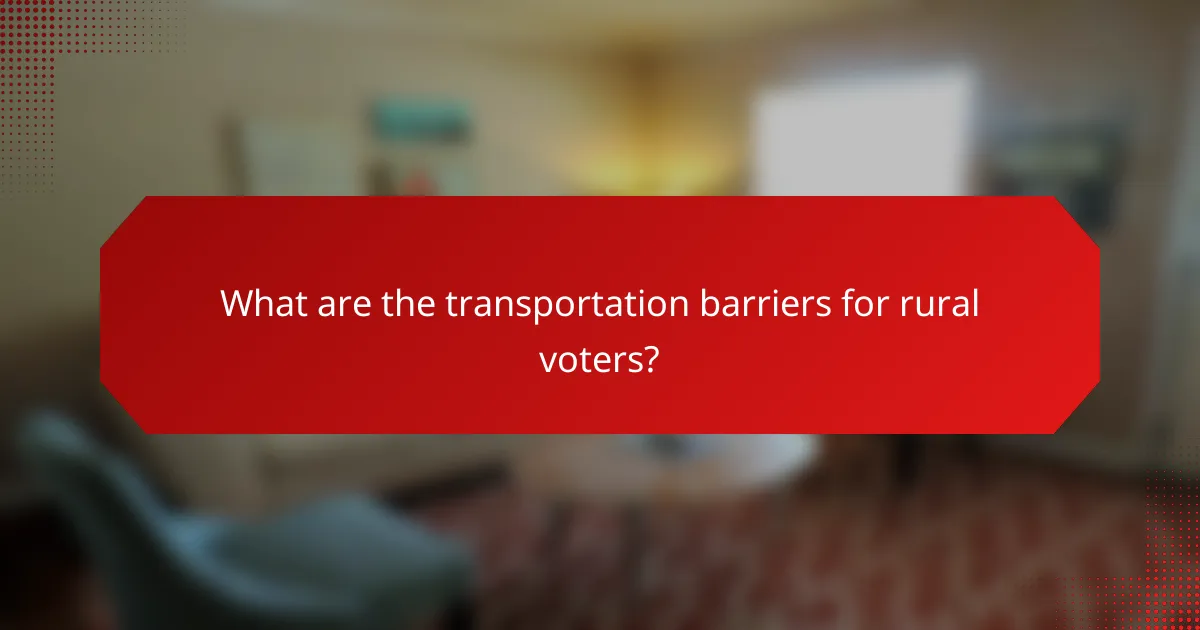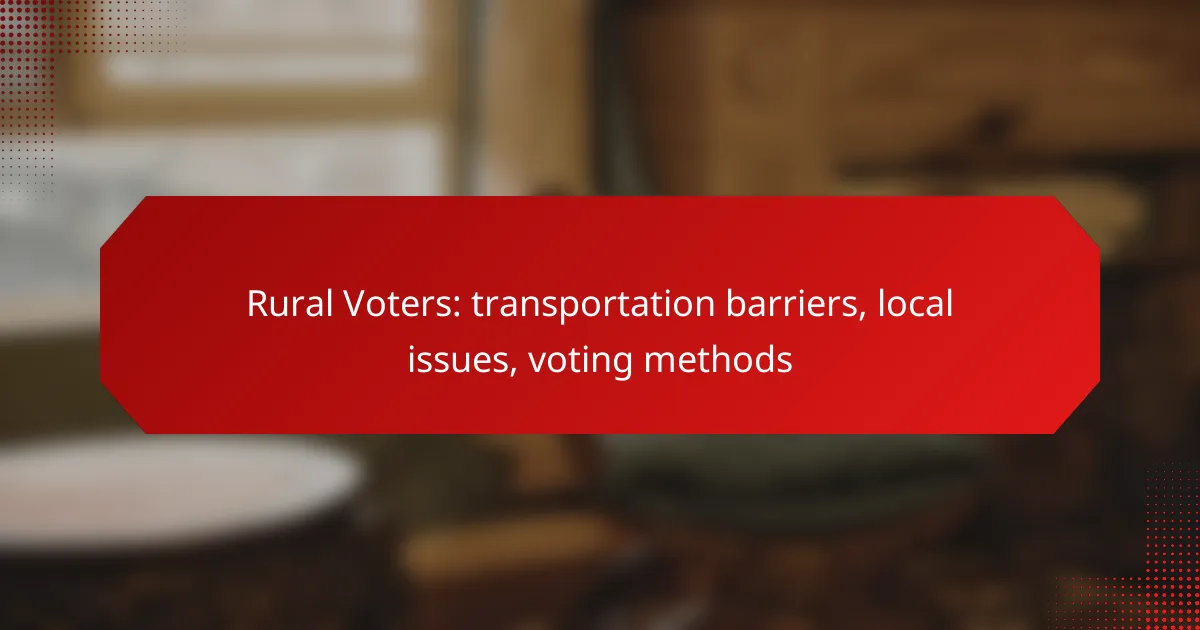Rural voters often encounter significant transportation barriers that impede their ability to engage in the electoral process, such as limited public transit and long distances to polling places. Local issues play a crucial role in shaping voter turnout, as unmet community needs can diminish motivation to participate. Additionally, rural voters have various voting methods available, including in-person, mail-in, early, and absentee voting, each with unique procedures that affect accessibility and participation.

What are the transportation barriers for rural voters?
Rural voters face significant transportation barriers that can hinder their ability to participate in elections. These challenges include a lack of public transit, long distances to polling places, limited ride-sharing options, inadequate road infrastructure, and accessibility issues for disabled individuals.
Lack of public transit options
Many rural areas lack reliable public transit systems, making it difficult for residents to reach polling places. Without buses or trains, voters often have no choice but to rely on personal vehicles or informal transportation methods.
This absence of public transit can disproportionately affect low-income individuals who may not own a car, further complicating their ability to vote.
Long distances to polling places
Rural voters frequently face long distances to their designated polling locations, which can be several miles away. This distance can discourage individuals from making the trip, especially if they lack transportation.
In some cases, voters may need to travel over an hour to reach a polling place, making it essential for local governments to consider more accessible voting options.
Limited ride-sharing services
Ride-sharing services like Uber and Lyft are often less available in rural areas compared to urban centers. This limited access can leave voters with few options for transportation on election day.
Even when ride-sharing is available, the cost may be prohibitive for some individuals, particularly those on fixed incomes.
Inadequate road infrastructure
Poor road conditions in rural regions can create additional barriers for voters trying to reach polling places. Unpaved roads, potholes, and lack of signage can make travel difficult and unsafe.
These infrastructure issues can lead to delays and may deter individuals from voting altogether, particularly during inclement weather.
Accessibility issues for disabled voters
Disabled voters in rural areas often encounter specific transportation challenges that can prevent them from voting. Many polling places may not be equipped with the necessary accommodations, such as wheelchair access or designated parking.
Additionally, the lack of accessible transportation options can further isolate disabled individuals, making it crucial for local authorities to address these barriers to ensure equitable voting access.

How do local issues affect rural voter turnout?
Local issues significantly influence rural voter turnout by shaping the priorities and concerns of the community. When voters feel that their immediate needs are not being addressed, they may be less motivated to participate in elections.
Economic challenges in rural communities
Economic challenges, such as high unemployment rates and low wages, can deter rural residents from voting. When individuals are struggling to make ends meet, they may prioritize work and survival over civic engagement.
Additionally, limited access to resources and financial instability can lead to feelings of disenfranchisement, making it less likely for these voters to believe that their participation will lead to meaningful change.
Access to healthcare and education
Access to healthcare and education is often limited in rural areas, which can impact voter turnout. When residents face long travel times to reach medical facilities or educational institutions, they may feel overwhelmed by these barriers, leading to decreased civic participation.
Moreover, issues such as inadequate funding for local schools and healthcare services can create a sense of urgency among voters, prompting them to engage in elections that address these critical local issues.
Impact of agriculture policies
Agriculture policies play a crucial role in rural communities, affecting everything from crop prices to subsidies. Farmers and agricultural workers are particularly sensitive to changes in policy, which can directly influence their livelihoods.
When agricultural policies are perceived as unfavorable, it can galvanize rural voters to participate in elections to advocate for their interests, thus increasing voter turnout when these issues are at stake.
Concerns over land use and zoning
Land use and zoning regulations can significantly affect rural communities, influencing development, property rights, and environmental conservation. Residents may become motivated to vote when they feel that their land and resources are threatened by proposed changes.
Active engagement in local elections can provide residents with a platform to voice their concerns about land use, ensuring that their needs and preferences are considered in decision-making processes.

What voting methods are available for rural voters?
Rural voters have several methods available for casting their ballots, including in-person voting at local precincts, mail-in voting, early voting, and absentee ballots. Each method has its own procedures and considerations that can impact accessibility and participation.
In-person voting at local precincts
In-person voting allows rural voters to cast their ballots at designated polling places on Election Day. Polling locations may be limited, so it’s essential for voters to check their precinct assignments ahead of time. Typically, voting hours range from early morning until evening, accommodating various schedules.
Rural voters should consider transportation options to reach polling places, as distances can be significant. Carpooling with neighbors or arranging rides can help mitigate transportation barriers.
Mail-in voting options
Mail-in voting, also known as absentee voting by mail, enables rural voters to receive and submit their ballots via postal service. Voters must request a mail-in ballot ahead of time, often requiring them to complete an application form. Deadlines for requesting and returning ballots vary by state, so checking local regulations is crucial.
This method can be particularly beneficial for those with limited transportation options or health concerns. Voters should ensure they allow sufficient time for mail delivery to avoid missing submission deadlines.
Early voting availability
Early voting provides rural voters with the opportunity to cast their ballots before Election Day at designated locations. The availability of early voting varies by state, with some offering several days to weeks of early voting periods. This flexibility can help voters avoid long lines and scheduling conflicts on Election Day.
Rural voters should verify early voting locations and hours, as they may differ from regular polling places. Planning ahead can enhance the voting experience and reduce last-minute issues.
Absentee ballot procedures
Absentee ballots allow voters who cannot be present at their polling place on Election Day to participate in the election. To obtain an absentee ballot, voters typically need to apply through their local election office, providing a valid reason for their absence. States may have different rules regarding eligibility and application processes.
Once received, voters must complete the ballot and return it by mail or in person by the specified deadline. It’s advisable to check local guidelines to ensure compliance with all requirements, including signature matching and ballot secrecy.

What are the prerequisites for voting in rural areas?
Voting in rural areas typically requires meeting specific prerequisites such as voter registration, identification, and awareness of local voting methods. Understanding these requirements is essential for ensuring participation in elections.
Voter registration deadlines
Voter registration deadlines can vary by state, but they generally fall a few weeks before an election. In many rural areas, it’s crucial to register early to avoid last-minute issues, especially if you rely on mail or in-person registration methods.
For example, some states allow registration up to 30 days before an election, while others may offer same-day registration. Always check your local election office for the exact deadlines and procedures applicable in your area.
Identification requirements
Identification requirements for voting can differ significantly between states, especially in rural regions. Some states require a photo ID, while others may accept non-photo identification or even allow voters to sign an affidavit if they lack ID.
It’s important to verify what forms of ID are acceptable in your state well before election day. For instance, a driver’s license or state-issued ID is commonly accepted, but some areas may also accept utility bills or bank statements as proof of residency.

How can rural voters advocate for better transportation?
Rural voters can advocate for better transportation by organizing community efforts and engaging with local governments. These actions can help highlight the transportation barriers they face and push for solutions that improve access to polling places and other essential services.
Community organizing initiatives
Community organizing initiatives focus on bringing together residents to address transportation issues collectively. This can include forming local advocacy groups that meet regularly to discuss challenges and brainstorm solutions, such as carpooling systems or shuttle services to polling locations.
Additionally, hosting community forums can raise awareness about transportation barriers. These events allow residents to share personal experiences and gather support for proposed initiatives, making it easier to present a united front when approaching local authorities.
Engagement with local governments
Engaging with local governments is crucial for rural voters seeking transportation improvements. Voters can attend town hall meetings to voice their concerns, propose specific transportation projects, and request funding for public transit options that cater to rural areas.
Building relationships with local officials can also facilitate ongoing dialogue about transportation needs. Voters should consider forming coalitions with other community organizations to amplify their message and increase the chances of securing government support for transportation initiatives.
